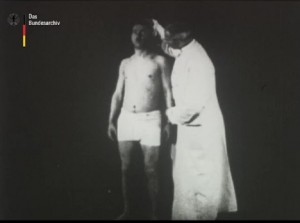By Juliet Wagner (Regular Contributor)
 War wounds take various forms, psychological wounds no less than disabilities resulting from obvious physical injury or amputation. During the First World War, many soldiers without detectable physiological damage nonetheless presented with physical symptoms, their bodies trembling, jerking or contorted as a consequence of “traumatic” experiences. In Britain, this condition became known as ‘shell shock.’
War wounds take various forms, psychological wounds no less than disabilities resulting from obvious physical injury or amputation. During the First World War, many soldiers without detectable physiological damage nonetheless presented with physical symptoms, their bodies trembling, jerking or contorted as a consequence of “traumatic” experiences. In Britain, this condition became known as ‘shell shock.’
Hypnotic cures
Treating and curing these conditions in order to return soldiers to effective service was a challenge taken up on both sides of the conflict by psychiatrists and neurologists eager to establish the reputation of their fledgling professions. For treatment, these doctors relied on a mish-mash of old techniques and experimental methods. In Britain and Germany, medical experts largely converged on the conviction that only psychological methods could treat conditions that resulted from emotional wounds.
One of the more controversial methods employed to treat shell shock was hypnosis. The Hamburg neurologist Max Nonne was the most prominent proponent of hypnosis treatment for war neurosis; although he was aware of the psychoanalytic approaches of colleagues in Vienna, his own motivation for hypnotizing patients was quite different from Sigmund Freud’s. Nonne did not wish to expose and release his patients’ inner unconscious, but rather to use hypnosis to take control of his patients’ bodies and restore them to health, like the inverse of a music-hall hypnotist who might convince a subject that they could not use their right leg, or that their hands were stuck together. Nonne was quite explicit about his use of medical power to discipline and impress his patients with his authority. In an article he wrote after the war, he admitted, “I always had patients undress to complete nakedness, since I found that one could thereby increase their feeling of dependence and helplessness.”
Shell Shock Cinema
A remarkable film was made of Max Nonne’s practice of curing patients through hypnosis, in Hamburg Eppendorf Hospital in 1916/17. It shows Nonne’s assistant stroking and manipulating the limbs of a series of hypnotized patients, re-enacting their earlier war neurosis symptoms. The film, ‘Funktionell-motorische Reiz- und Lähmungs-zustände und deren Heilung durch Suggestion in Hypnose,’ is approximately eleven minutes long, and shows a series of fourteen patients, both before and after treatment (the inter-titles inform the viewer), beginning with a patient suffering from severe stutter, through paralyses, to more spectacular walking disorders, in the case of the final patient, complete with full-body tremors and erratic head-jerking motions. In the film, each patient appears against a black background, dressed only in white underpants, and, with the exception of the first shot, which is a close-up of the head and shoulders of a patient with a serious stutter (presumably to highlight his stutter, as the film is silent), the patient’s entire body is shown.
The dominant figure in the film is the physician, who appears in each case, stroking and tapping the affected limbs, speaking to the patient, and occasionally, once the symptoms have disappeared, looking briefly into the camera, as if in triumph. The effect of the physician as a magician or puppeteer is heightened by a number of details, whether intentional or not, it is impossible to judge: firstly, the white coat the doctor is wearing is extremely long, making him appear improbably tall and seem to float against the black background, his hands ‘disappearing’ when his arms fall to his sides. Due to the way the film is edited, he also occasionally ‘pops’ into the picture and often appears from different sides of the screen in quick succession, adjusting and manipulating his patient’s limbs. Finally, the most striking scene in the film features the doctor supporting a patient by his arms, while the patient pedals round him in a circle with his one functioning leg, making the two appear like macabre, mismatched dance partners, led by the erect, white-coated doctor.
The full film was recently made available online by the German Federal Archive and can be viewed here:
Further Reading:
I write extensively about this and other ‘war neurosis’ films, about the legacy of Jean-Martin Charcot and Albert Londe, and about the connection between hypnosis/suggestion and cinema, in my forthcoming book.
For more on Max Nonne, his film and the German approaches to ‘shell shock’ in WWI, see Paul Lerner’s Hysterical Men: War, Psychiatry, and the Politics of Trauma in Germany, 1890–1930 (Cornell UP, 2003). On the medical response to war neurosis in Austria-Hungary, see Hans-Georg Hofer, Nervenschwäche und Krieg: Modernitätskritik und Krisenbewältigung in der österreichischen Psychiatrie (1880-1920) (Böhlau, 2004).
